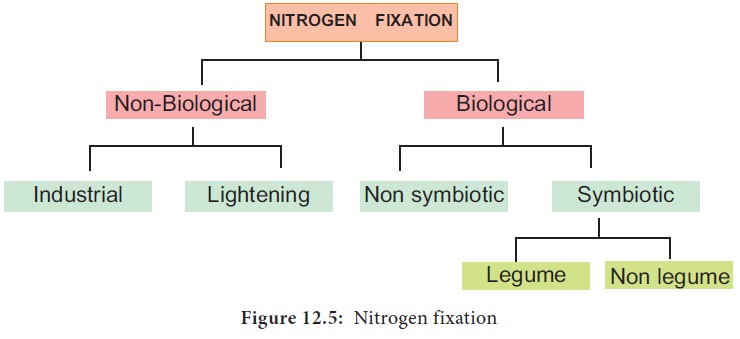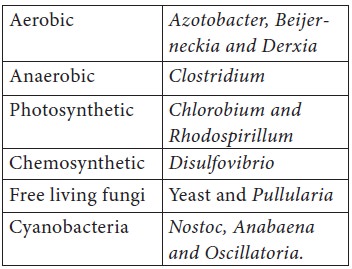Chapter: 11th Botany : Chapter 12 : Mineral Nutrition
Nitrogen Fixation
Nitrogen Fixation
Inspiring
act of nature is self-regulation. As all living organisms act as tools for bio
geo chemical cycles, nitrogen cycle is highly regulated. Life on earth depends
on nitrogen cycle. Nitrogen occurs in atmosphere in the form of N2
(N≡N), two nitrogen atoms joined
together by strong triple covalent bonds. The process of converting atmospheric
nitrogen (N2) into ammonia is termed as nitrogen fixation. Nitrogen
fixation can occur by two methods: 1. Biological; 2. Non-Biological (Figure 12.5).

Activity
Preparation of Solution Culture to find out Mineral Deficiency
1.
Take a glass jar or polythene bottle
and cover with black paper (to prevent algal growth and roots reacting with
light).
2.
Add nutrient solution.
3.
Fix a plant with the help of split
cork.
4.
Fix a tube for aeration.
5.
Observe the growth by adding specific
minerals.
1. Non – Biological nitrogen fixation
•
Nitrogen fixation by chemical process in industry.
•
Natural electrical discharge during lightening
fixes atmospheric nitrogen.
2. Biological nitrogen fixation
Symbiotic
bacterium like Rhizobium fixes
atmospheric nitrogen. Cyanobacteria found in Lichens, Anthoceros, Azolla and coralloid roots of Cycas also fix nitrogen. non-symbiotic (free living bacteria) like Clostridium also fix nitrogen.
a. Symbiotic nitrogen fixation
i. Nitrogen fixation with nodulation
Rhizobium bacterium is found in leguminous plants and fix atmospheric nitrogen.
This kind of symbiotic association is beneficial for both the bacterium and
plant. Root nodules are formed due to bacterial infection. Rhizobium enters into the host cell and proliferates, it remains separated from the host cytoplasm by a
membrane (Figure 12.6).
Stages of Root nodule formation:
1. Legume
plants secretes phenolics which attracts Rhizobium.
2. Rhizobium reaches the rhizosphere and enters into the root hair, infects
the root hair and leads to curling of root hairs.
3. Infection thread grows inwards and separates the infected tissue from normal tissue.
4.
A membrane bound bacterium is formed inside the
nodule and is called bacteroid.
5.
Cytokinin from bacteria and auxin from host plant
promotes cell division and leads to nodule formation

Activity
•
Collect roots of legumes with root
nodules.
•
Take cross section of the root
nodule.
•
Observe under microscope. Discuss
your observations with your teacher.
Non-Legume
Alnus and Casuarina contain
the bacterium Frankia. Psychotria contains the bacterium Klebsiella.
ii. Nitrogen fixation without nodulation
The following plants and prokaryotes are involved
in nitrogen fixation.
Lichens -
Anabaena and Nostoc
Anthoceros
- Nostoc
Azolla - Anabaena azollae
Cycas - Anabaena and Nostoc
b. Non-symbiotic Nitrogen fixation
Free
living bacteria and fungi also fix atmospheric nitrogen.

Related Topics